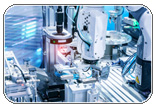Non-contact recording of temperature data with Ex thermography Cameras in a rapeseed oil refinery

Efficient monitoring of a production hall with imaging and thermographic Ex-Cameras from SAMCON
Project planning
In an oil refinery, a tightrope walk between heat and pressure is inevitable. The process of oil production involves hazardous areas, a temperature range of up to 100° during the processing process, the use of solvents to wash out residual oil and a press to extract the oil.
In addition to “normal” IP surveillance cameras, thermography cameras should also be used to monitor the production hall of the rapeseed oil refinery. Monitoring the electric motors located in the hall is crucial for maintaining operational efficiency and preventing unplanned outages. A promising method for monitoring engines is the use of thermal imaging cameras. These enable non-contact collection of temperature data, which can indicate potential problems and irregularities in operation. The health protection and occupational safety of employees must be ensured. The combination of thermal imaging and optical cameras with advanced analysis functions enables non-contact recording of temperature data during ongoing operation.
Thermal imaging cameras capture infrared radiation from objects at any time and convert it into a thermographic image. This allows temperature differences in different areas of production to be recorded. The Ex-Camera used offers integrated, user-configured functions such as: B. starting video recording and sending alarm notifications. The data is transmitted via video stream over the network and can be accessed locally and remotely. By analyzing temperature patterns, potential problems such as overheating, uneven loading or faulty components can be identified without people being in the danger area. Response time to incidents is minimized.
- So our ex-cameras help with thatIncreased efficiency: through regular monitoring, maintenance work can be planned specifically, which reduces downtime and increases operational efficiency
- Early detection: early detection of overheated components or irregularities, prevention of possible serious damage
- Safety: non-contact detection, selectively and throughout the entire detection area
Other practical areas of application
- Monitoring of motors: early detection of insulation problems, bearing overheating
- Industrial systems: monitoring motors in conveyor belts, pumps, fans
- Monitoring of motors for electric drives



